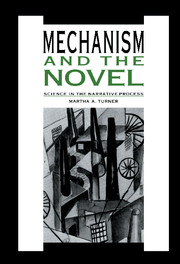Book contents
- Frontmatter
- Contents
- Acknowledgments
- 1 Introduction
- 2 The concept of mechanism
- 3 The Aristotelian logic of settlement in Austen's Pride and Prejudice
- 4 Scott's The Bride of Lammermoor: empiricism, mechanism, imagination
- 5 Cosmology and chaos in Dickens's Bleak House
- 6 Scientific humanism and the Comic Spirit: from The Ordeal of Richard Feverel to The Egoist
- 7 Old mindsets and new world-music in Conrad's The Secret Agent
- 8 Women in Love: beyond fulfillment
- 9 The mechanistic legacy: Lessing's Canopus in Argos: Archives
- Notes
- Bibliography
- Index
4 - Scott's The Bride of Lammermoor: empiricism, mechanism, imagination
Published online by Cambridge University Press: 19 January 2010
- Frontmatter
- Contents
- Acknowledgments
- 1 Introduction
- 2 The concept of mechanism
- 3 The Aristotelian logic of settlement in Austen's Pride and Prejudice
- 4 Scott's The Bride of Lammermoor: empiricism, mechanism, imagination
- 5 Cosmology and chaos in Dickens's Bleak House
- 6 Scientific humanism and the Comic Spirit: from The Ordeal of Richard Feverel to The Egoist
- 7 Old mindsets and new world-music in Conrad's The Secret Agent
- 8 Women in Love: beyond fulfillment
- 9 The mechanistic legacy: Lessing's Canopus in Argos: Archives
- Notes
- Bibliography
- Index
Summary
Sir Walter Scott was educated in the tradition of the Scottish Enlightenment. The eighteenth-century Scottish intellectuals, like the “natural philosophers” from whom they drew inspiration, held that all knowledge of human and natural phenomena was derived from empirical observation, that the world was constantly undergoing change, and that these changes followed certain fundamental laws which could be detected by the careful observer. Scott's comments in essays and letters suggest a fairly thorough assent to these mechanistic assumptions. In Life of Dryden, he praises Dryden for recognizing the beginning of the era of experimental science and for celebrating the “downfall of the Aristotelian tyranny.” Edgar Johnson, arguing that Scott was no reactionary enemy to constitutional change, cites a comment Scott made to Edward Cheney near the end of his life: “If the machine does not work well, it must be mended.” The use of the term “machine” as a non-pejorative metaphor for the political system is striking in one who has sometimes been identified as a Burkean conservative. Scott implemented the tenets and products of mechanistic science in immediate practical concerns as well. A proponent of applying the latest scientific findings and technological contrivances to agriculture, Scott was renowned an “improver” of his own estates. He also admired Sir Humphry Davy, whose research into soil compositions gave impetus to the early nineteenth-century “improving landlord” movement. Moreover, Scott was one of the first entrepreneurs to employ steam presses in his printing plant, and he praised mechanical innovations in other industries.
- Type
- Chapter
- Information
- Mechanism and the NovelScience in the Narrative Process, pp. 63 - 78Publisher: Cambridge University PressPrint publication year: 1993



